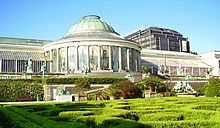Le Botanique

Le Botanique (French) or Kruidtuin (Dutch) is a cultural complex and music venue in Saint-Josse-ten-Noode, Brussels. The building was previously the main orangery of the National Botanic Garden of Belgium and even as part of the garden had hosted cultural events. In 1958, the National Botanic Garden of Belgium moved to Meise, outside of Brussels. Le Botanique opened in 1984, and the gardens in front are now the Botanical Garden of Brussels.
History
The first botanic garden in Brussels belonged to the Ecole Centrale du Département de la Dyle that was created during the French rule of Belgium at the end of the 18th century. Due to their costs, those French schools were soon dropped and some municipalities, including the City of Brussels, took over the garden that was about to be abandoned. In 1815, Belgium became part of the United Kingdom of the Netherlands. Around the same period, the maintenance costs of the garden were regarded as too high by the city administration. A group of local bourgeois decided to create a new kind of botanical garden in Brussels. At the time the bourgeoisie was the new leading-class and since companies were popular financing method the garden was created as a company. The creators thought it would be their contribution to the city's reputation. Although it was rooted on a private enterprise, it was also supposed to be a national institution dedicated to science.
Both the City and the Home Office supported it financially. But, the Independence of Belgium (1830-1831) was detrimental to the Dutch-born institution: it was regarded as Orangist, as a mere playground for the local elites, and as not useful for the country's agriculture, among other critiques. From then on, the garden would have to battle to survive. The state and the city did not want to support it anymore unless it proved useful to the whole country, so the Garden was obliged to develop its commercial activities. It sold plants by the thousands, and created several money-consuming attractions and events for the local élite, like aquaria, a dance room, fairs, a fish nursery, concerts etc. In the 1860s, the aging buildings required renovation. The board of the Society of Horticulture tried to raise the money, but the costs were just too high for the company. In 1870, the Belgian Government took over the company. The National Botanic Garden was created in the very same year. Barthélemy Dumortier (1797-1878), a Belgian politician and botanist, had played a major role in this process. He wanted a "Belgian Kew" to be created in the capital of Belgium, that is to say a botanical garden dedicated to taxonomy. That is why, some months before the garden was bought by the state, the Belgian Government had purchased the famous von Martius Herbarium that was held in Munich. So, in 1870, Belgium had a great herbarium and an appropriate building. This was the dawn of a new era for Belgian botany.
-

A bench in the Rotunda
-

The Rotunda
-

Indoor
References
External links
| Wikimedia Commons has media related to Botanique (building). |
| ||||||||||||||
Coordinates: 50°51′17″N 4°21′55″E / 50.85472°N 4.36528°E